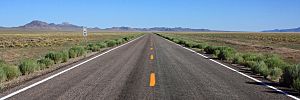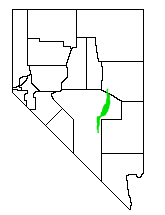Railroad Valley (Nevada) facts for kids
Railroad Valley is a long, wide valley located in the middle of Nevada, USA. It's part of the Great Basin Desert, which is a large, dry area. The valley stretches about 80 miles (129 km) from north to south and can be up to 20 miles (32 km) wide. Some parts in the south even run from southwest to northeast.
About Railroad Valley
This valley starts near Gray Top Mountain in the south and goes all the way north to Mount Hamilton. Tall mountain ranges surround the valley. To the east, you'll find the Quinn Canyon Range, Grant Range, and White Pine Range. To the west are the Pancake Range and Reveille Ranges.
Most of Railroad Valley is in Nye County, Nevada. However, its northern tip reaches into White Pine County, Nevada. The valley is home to many natural springs, like Kate Springs and Blue Eagle Springs. You can also find ranches here, such as the Blue Eagle Ranch.
Communities and Wildlife
Several small communities are located in Railroad Valley, including Currant, Nevada, Crows Nest, Green Springs, Lockes, and Nyala. The valley also has four special areas called "Railroad Valley Wildlife Management Areas." These places help protect the local animals and plants.
Oil Production
Railroad Valley is very important for Nevada's energy. It's where most of the state's oil comes from! There are several small oil fields here, like Eagle Springs, Trap Spring, and Grant Canyon. For example, in 2002, these fields produced about 553,000 barrels of oil.
Native American Heritage
Railroad Valley is the original home of the Tsaidüka people. They are a group of Western Shoshone Native Americans. Today, many of them are part of the Duckwater Shoshone Tribe of the Duckwater Reservation. They have a deep connection to this land and its history.




